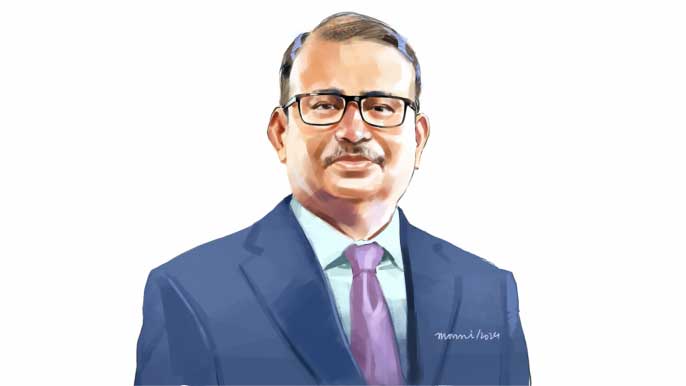How EBL rose from the ashes of BCCI to become a top bank
Sensing the depositors' concern, the Bangladesh Bank took immediate action to seize BCCI's assets in the country to prevent further financial instability and secure the interests of the depositors.
To manage the aftermath of BCCI's collapse and to provide a solution for the affected customers, the Bangladesh Bank came up with a restructuring plan that facilitated the creation of Eastern Bank Limited
Eastern Bank's journey started with an accumulated loss of Tk314 crore and its directors held off from taking any dividends or fees until the bank became profitable, which took a time span of six years. Currently, the bank's performance indicators surpass most others, including some that are older than EBL.
Also, EBL is categorised as one of the top banks in Bangladesh. EBL is the first bank in the country to be rated by Moody's and awarded the London-based prestigious Best Bank of Bangladesh by The Banker three times. Despite a heavy focus on corporate lending with 78% of its loans being corporate in 2023, the bank managed to maintain its non-performing loan (NPL) ratio at 3.1%, one of the lowest in the country.
By the close of 2023, EBL boasted a return on equity of 16.33% and an NPL coverage ratio of nearly 150%. In a year where many banks experienced a decline in deposits, EBL defied the trend by increasing its deposits by 15.45%, loans and advances by 14.39%, and profit after tax by nearly 20%, reaching Tk611 crore.
The bank's capital to risk-weighted assets ratio rose to over 15%, well above the required 12.5%. EBL is now one of the top dividend-paying banks in the country, having paid 25% dividends for the last three consecutive years. Also, the bank's cost-to-income ratio stands at only 44.22%, compared to the banking industry average of over 50%. This means EBL spends Tk44.22 to earn Tk100.
But if we rewind to the 1990s, we will see a different picture. The bank's NPL was 8.77% in 1999, with its net profit at less than Tk41 crore. Also, NPL rose to 11.52% in 2001 and 13.61% in 2003. In 1995, the bank's operating income was less than Tk43 crore, and it soared to Tk2,053 crore in 2023.
How was the transformation possible?
When the BCCI collapsed in 1991, Mir Nasir Hossain, a significant depositor in the bank, had grave concerns and frustration. However, when the central bank introduced a reconstruction scheme for the BCCI, he felt a sense of relief.
The scheme offered depositors two options: Either become shareholders against their deposits or receive their deposits back at reduced rates over five years. Mir Nasir chose to become a shareholder and consequently became a director of EBL, along with M Ghaziul Haque, Md Showkat Ali Chowdhury – the current chairman of the bank, AM Shaukat Ali, and Mohd Noor Ali.
"From day one, we started working to turn the bank around, beginning with an assessment of the liabilities. It was a time-bound plan, and eventually, EBL came to a breakeven position in five to six years," Mir Nasir Hossain told The Business Standard.
Introducing IT in the bank in 2002 was a turning point, he said. "Customers were able to do banking from any branch, regardless of where their account was held."
Then EBL was staffed with a new management team to ensure that the practices that led to BCCI's downfall were not repeated. Accordingly, EBL hired a group of high-quality personnel with experience in multinational banks, said Mir Nasir, a former chairman of EBL and former president of the FBCCI.
"We gave them freedom and rewarded performance. We [directors] helped with policy-making and accountability checks but never interfered in management decisions," he said, adding that the board of directors did not take any fees for over five years.
"Getting K Mahmood Sattar as CEO of EBL in 2002 was another turning point for the bank," he said. At that time, Sattar joined Standard Chartered Bangladesh after its acquisition of ANZ Grindlays' Bangladesh operations.
Professionalism and neutrality
Now, EBL is so professionally and neutrally run that its board of directors refrains from banking with their bank to avoid conflicts of interest. "If a bank's board of directors works honestly, sincerely, and pragmatically, the bank will surely become a good bank," said Mir Nasir Hossain.
Mahmood Sattar still remembers how difficult those days were after joining EBL. He took on the challenge of transforming the bank and succeeded. How did he do it?
"EBL was the first bank in Bangladesh to introduce core banking software and any branch banking back in 2003," said Sattar. "The next step was the segmentation of businesses into corporate, retail, and SMEs."
Later, EBL introduced policies such as for credit and IT and made banking processes centralised.
"Since then, the bank has never looked back. It is now one of the most tech-savvy banks in the country," he told The Business Standard.
Ali Reza Iftekhar, the current managing director of EBL, joined in 2004 as a deputy managing director. He became the MD in 2007 and has since led the bank's transformation.
"When we were undergoing restructuring, we also focused on business growth and branding of the bank. Our plan worked successfully," Iftekhar told The Business Standard.
He noted that EBL's average non-performing loan (NPL) ratio over the last 10 years has been around 3%, a figure that surprises many given EBL's heavy focus on corporate banking.
Why EBL can, others can't
Established in 1992, EBL has only 85 branches, significantly fewer than many other banks, including 2013's 4th generation banks. Nonetheless, it consistently generates higher profits than banks with a greater number of branches. How does it achieve this?
Customers' trust and due diligence are key to the bank's steady growth, according to the bank's managing director.
An AAA-rated company now, EBL's philosophy is "quality over quantity," said Iftekhar, who is the longest-serving MD of a bank in Bangladesh. "If you can ensure the quality of services and products, the business will come automatically."
He said EBL always aims to reach out to clients rather than bringing them into the bank's branches. This approach is reflected in the bank's branch count—only 85—which is the lowest among all first, second, and third-generation banks. It also helps EBL cut establishment costs, he said.
"We have a large team of relationship managers and sales personnel who directly visit clients to serve them," he said. Regarding the bank's low NPL, he mentioned that they have a strong collection team, adding 25 to 30 personnel to it every year.
When customer confidence in low-performing banks dwindled last year mainly due to governance concerns, EBL continued to grow as a preferred bank for customers for its track record of championing compliance, said the MD.
He stated that since 2007, EBL has never breached any regulations. The bank winning five gold awards since the inception of the ICSB National Award for Corporate Governance Excellence in 2013 is a testimony to EBL's sound governance culture.
"Our consistent adherence to rigorous credit policies and underwriting practices in lending and customer selection along with vigorous collection and monitoring drive helped us close the year 2023 with a record net profit," he told TBS.
Link: https://www.tbsnews.net/economy/banking/how-ebl-rose-ashes-bcci-become-top-bank-863256








